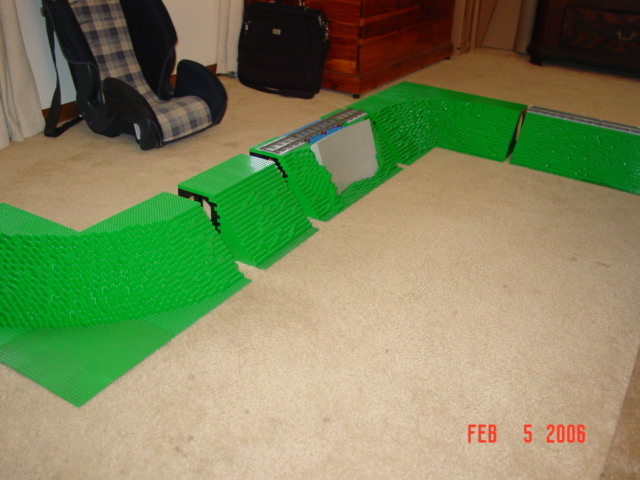Subject:
|
Re: Modular Hill Standard
|
Newsgroups:
|
lugnet.trains
|
Date:
|
Mon, 6 Feb 2006 18:29:05 GMT
|
Viewed:
|
4363 times
|
| |

|
|
In lugnet.trains, Paul Janssen wrote:
| |
COLTC, the Central Ohio LEGO Train Club, has come up with a modular hill
standard. The goal of this standard was to provide more height-variations
into layouts, and increase the number of running trains.

There are a variety of ways these modules can be used. On completely flat
layouts, they can be used at the inside of the layout, either as a section,
or as a full closed circuit. Trains can run on top, but also inside the
hills. Make an end-cap module, and the train comes out a tunnel, running on
the layout for a bit, and elsewhere dive back in. One could run the train in
a flat section outside, and hide it in another section.
On layouts that have different table levels, they can form transitions
between the levels. The standard (see below), is equal to the height
difference of our adjustable tables. The backsides of hte modules are
uniform, so if visitors look from the back-side, it will look nice as well.
The standard:
Sections are build on 32x32 baseplates. Corners consist of 3 baseplates in an
L-shpe, forming either an inside or outside corner (see folder for examples).
Other modules are full multiples of a 32x32 baseplate.
Height: modules are 16 bricks tall, measured form top of baseplate to top
green level. If a track is on top, there is an additional plate between track
and green. Use a light bley plate, 10-wide, so it looks like gravel ballast.
The plate also stabilizes the top brick level.
|
Snipped
| |
http://www.brickshelf.com/gallery/brickbuy/COLTChill/coltchill05.jpg
Back view. Black 2x2 pillars, with 1x8x2 arches. form each pillar, a 1x12x3
arch connects to the back wall. top level is all green.
Modules can be placed back-to-back, as nothing sticks out, forming a solid
hill.
Inside, it is best to make them pretty solid, so the can be transported in a
trailer, duplo and junk bricks work just fine.
Key parts needed for a single baseplate module:
5 1x12x3 arches black, 4 1x8x2 arch black, 1 baseplate, lots of green and
black 2xX bricks. Top level is best to use some large green bricks (8x16)
Some black inverted 45 degree slopes: 4 x 1x2 and 6 x 2x2. Plates for under
train track.
Modules can be plain (allowing for houses etc to be put in front of them, or
can be whatever. Also, only the sides need to adhere the the standard, the
module can go in and out in the middle, as long as it is back to the standard
where it connect to other modules. It can also be used for harbor scenes, so
trans run behing concrete walls, and/or on top. They can be build relatively
fast as well, a plain 1 baseplate module can be build in ~20 minutes when you
have all the parts at hand.
|
Paul,
how thick are you tables? We use mudular tables that can be adusted in hieght
and stacked apone each other to acheive some vertical change. But our tables
are 6 brick thick. To allow a train to run under a stacked table we have to set
it at +20 bricks higher then surrounding tables to allow a 14 brick clearance
below. I consider this a bit tall for many situations.
I like what you’ve done, but it looks like any stacked structure adjacent to a
hill modual will need to be a maximum of 2 brick thick. ~3/4 inch thick. Any
thoughts?
Mat
|
|
Message has 1 Reply:
 | | Re: Modular Hill Standard
|
| (...) Our tables are just over 4, but well under 5 bricks thick. We do not necessarily plan to run them under tables, it is mainly for on the tables, to give the layout a more real feel. In populated areas, trains often run elevated, so city streets (...) (18 years ago, 6-Feb-06, to lugnet.trains, FTX)
|
Message is in Reply To:
 | | Modular Hill Standard
|
| COLTC, the Central Ohio LEGO Train Club, has come up with a modular hill standard. The goal of this standard was to provide more height-variations into layouts, and increase the number of running trains. (URL) There are a variety of ways these (...) (18 years ago, 5-Feb-06, to lugnet.trains, lugnet.announce, lugnet.town, FTX) !!
|
7 Messages in This Thread:
  
  
    
    
- Entire Thread on One Page:
- Nested:
All | Brief | Compact | Dots
Linear:
All | Brief | Compact
This Message and its Replies on One Page:
- Nested:
All | Brief | Compact | Dots
Linear:
All | Brief | Compact
|
|
|
|